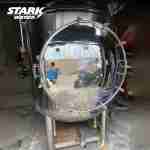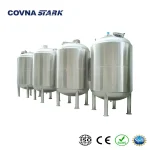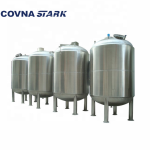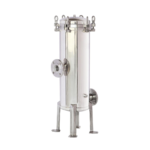Introduction: Why Tank Selection Matters
In industrial water systems, a storage tank is far more than just a container. It plays a critical role in buffering flow, maintaining hygiene, supporting downstream equipment, and ensuring long-term operational stability. However, not all tanks are created equal—and choosing the wrong type can lead to serious consequences.
A mismatched tank may cause chemical incompatibility, frequent maintenance issues, microbial contamination, or even safety hazards. Factors such as the liquid type, tank material, working pressure, installation environment, and industry regulations all affect which tank is right for your application.
This article will help you understand the different types of industrial water storage tanks, their respective strengths, and how to select the most suitable one based on your process requirements—not just price tags.
Common Types of Industrial Water Tanks
Industrial water tanks come in various materials and configurations, each designed for different process conditions, hygiene requirements, and chemical compatibilities. Understanding these differences is the first step in choosing the right tank for your facility.
1. Stainless Steel Tanks (SUS304 / SUS316L)
Stainless steel tanks are widely used in food, beverage, pharmaceutical, and high-purity water applications. SUS304 is suitable for general use, while SUS316L offers superior corrosion resistance—ideal for chloride-rich environments or sterile conditions.
2. FRP Tanks (Fiberglass Reinforced Plastic)
FRP tanks are lightweight, corrosion-resistant, and ideal for storing wastewater, chemical effluents, or aggressive liquids. Their modular construction allows for custom sizing and on-site assembly, especially for large-volume applications.
3. Plastic Tanks (HDPE / PE)
Plastic tanks are cost-effective for non-pressurized applications and commonly used in smaller-scale setups. However, they have limited durability under high temperature or structural stress.
4. Carbon Steel Tanks
Carbon steel tanks are durable and used in heavy industrial settings, often with internal coatings to resist corrosion. They are suitable for high-pressure or high-volume processes but require strict maintenance and corrosion monitoring.
5. Horizontal vs. Vertical / Closed vs. Open
Besides materials, tank orientation and top design also affect system integration. Vertical tanks save footprint and support gravity drain, while horizontal tanks are easier to install in low-ceiling facilities. Closed-top tanks are recommended for hygienic or odor-sensitive systems.
How to Choose: 5 Key Factors to Consider
Selecting the right industrial water tank isn’t just about size or price. The ideal tank must meet your specific process requirements, fluid properties, regulatory needs, and maintenance expectations. Here are five critical factors to guide your selection:
1. Fluid Type and Corrosiveness
If you're storing purified water, process liquids, or aggressive chemicals, material compatibility is essential. For example, SUS316L stainless steel is highly resistant to chlorides and ideal for pharmaceutical or food-grade use. For chemical wastewater or neutralization applications, FRP tanks offer superior chemical resistance at a lower weight.
Explore our full range of corrosion-resistant tanks here:
STARK Stainless Steel Tank Series
2. Operating Pressure and Temperature
Will your tank handle hot water, pressure cycles, or steam cleaning? If so, you’ll need materials that withstand thermal stress and structural pressure. Stainless steel and coated carbon steel are better suited for pressurized systems or CIP loops.
3. Volume and Usage Frequency
Is your system running continuously or in batches? Do you need buffer capacity for peak demand? Oversizing wastes space and budget; undersizing leads to flow instability. Our engineers can help calculate optimal capacity for each process point.
4. Cleanability and Hygiene Requirements
If your industry requires hygienic compliance—such as in food, beverage, or cosmetic production—opt for mirror-polished stainless steel tanks with CIP-ready design and sanitary fittings. Avoid flat bottoms and unventilated caps that create microbial hotspots.
5. Certification and Industry Standards
Some sectors require compliance with GMP, 3-A, or FDA standards. Confirm whether your process requires documented traceability, welding standards, or sanitary surface finish. Investing in certified tanks ensures long-term regulatory compliance and audit readiness.
Case Study Examples
Case 1: 316L Stainless Steel Tank in a Beverage Processing Plant
A beverage manufacturer needed a hygienic, corrosion-resistant tank to store RO-treated water for juice formulation. We supplied a 5,000-liter SUS316L stainless steel tank with mirror-polished interior (Ra ≤ 0.4 μm), top manhole, CIP spray ball, and sanitary valves. This ensured FDA-grade compliance and reduced cleaning downtime by 40%.
Case 2: FRP Tank for Electroplating Wastewater Storage
A metal finishing plant required a lightweight, acid-resistant tank for collecting rinsed wastewater with low pH and heavy metal traces. We designed a modular FRP tank (20,000 liters) with UV-resistant coating and sloped base for easy sludge drainage. The customer reported zero corrosion-related issues after 18 months of continuous use.
Case 3: Horizontal Tank for Low-Ceiling Utility Room
In a central utility building, space constraints limited the vertical height available for tank installation. Our team provided a horizontal SUS304 buffer tank (3,000 liters) with adjustable supports and lateral connections to fit under ceiling-mounted piping. The tank was integrated with a booster pump system and installed within 6 hours.
Conclusion: Choose Based on Process, Not Just Price
When selecting a water storage tank for your facility, don't settle for a one-size-fits-all solution. The right tank must align with your process fluid properties, hygiene needs, pressure conditions, and long-term maintenance expectations. A cheaper tank that fails prematurely or causes contamination may cost more in the long run than a well-matched, reliable one.
At STARK, we offer a wide range of industrial tanks—including stainless steel, FRP, and custom-engineered vessels—tailored to your application, industry, and certification needs. Whether you’re designing a new treatment line or upgrading an existing one, we’ll help you build a stable and efficient system from the tank up.
Need help choosing the right tank for your process?
Contact our engineering team today to receive design drawings, material recommendations, and a quote tailored to your needs.





